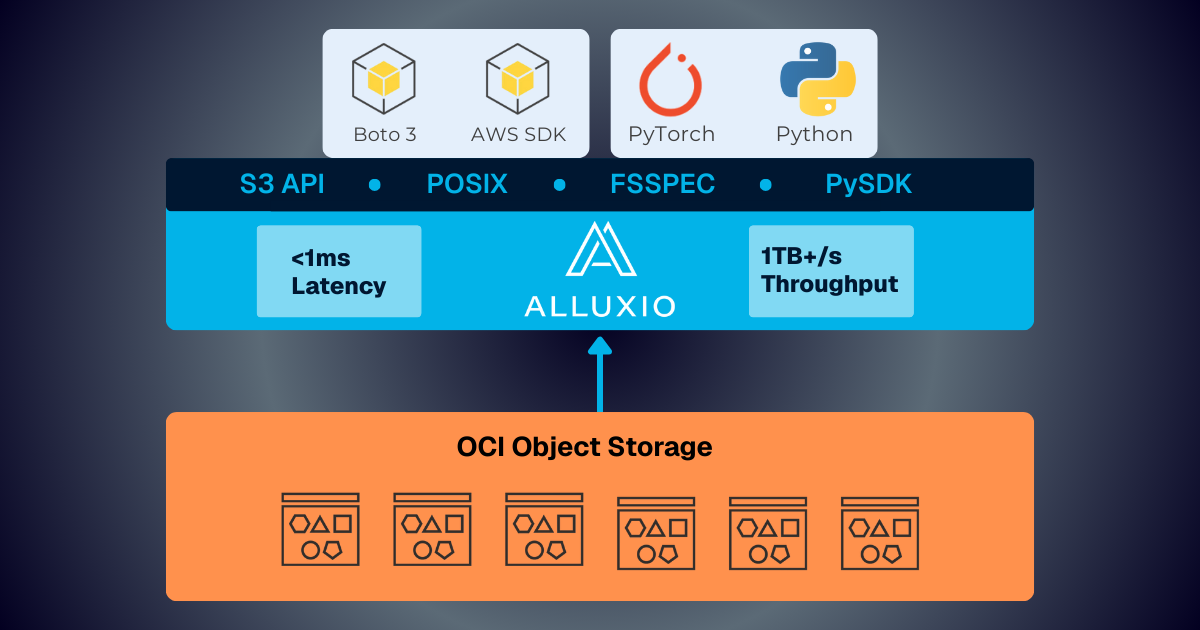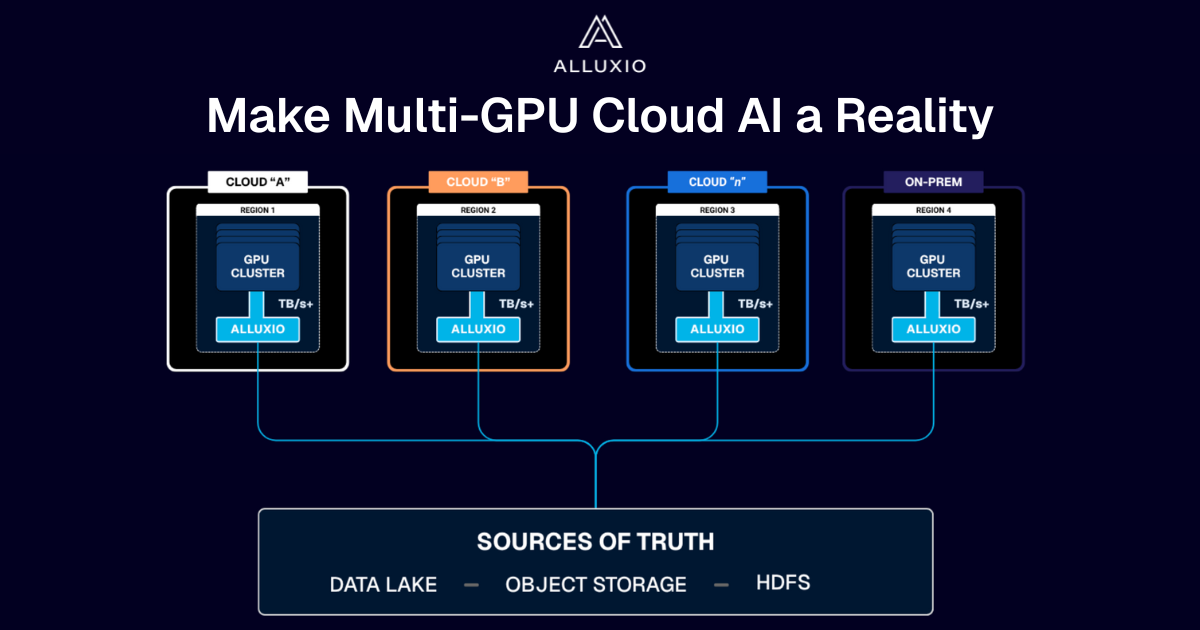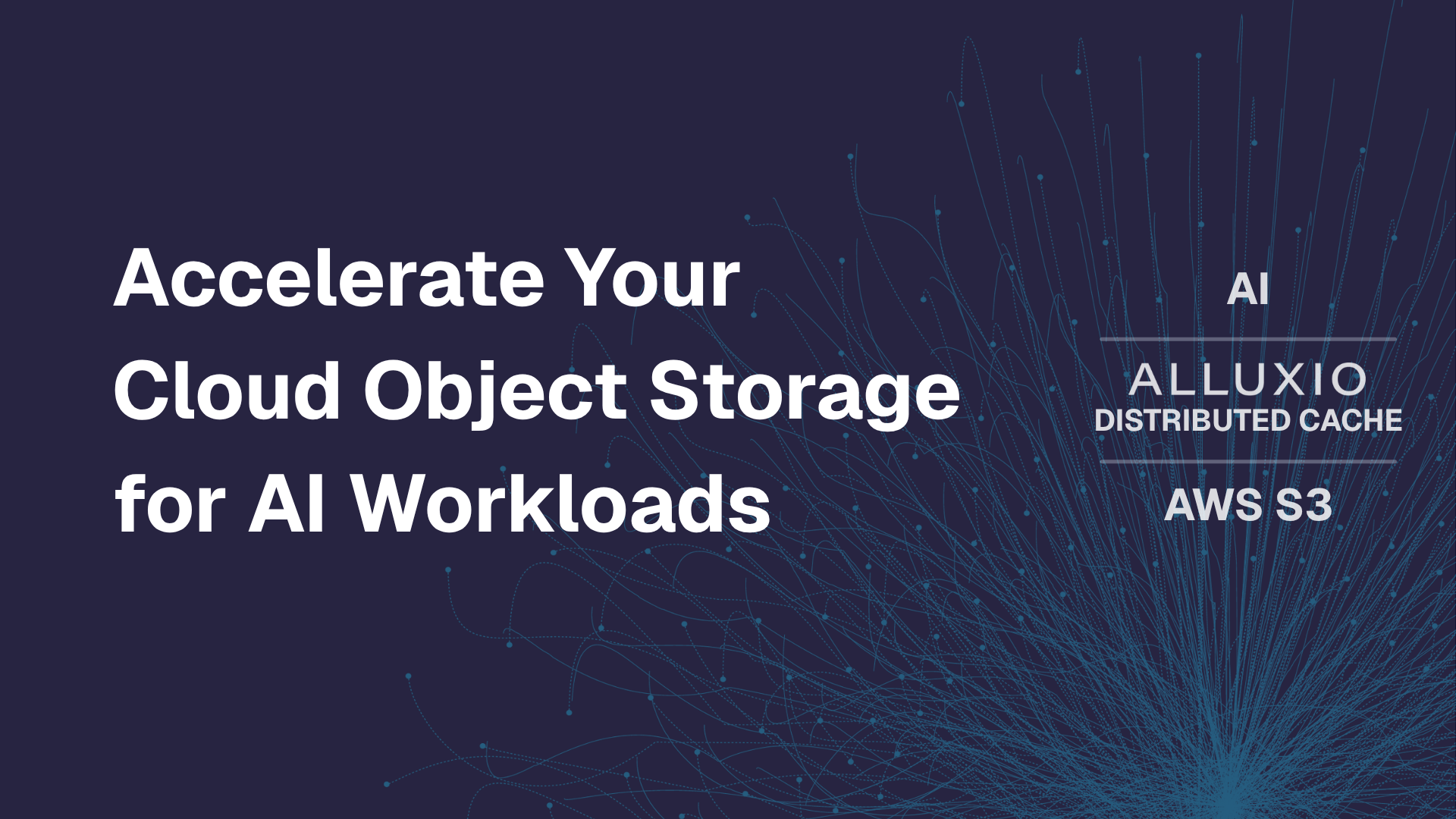Products
Blog

Alluxio and Oracle Cloud Infrastructure: Delivering Sub-Millisecond Latency for AI Workloads
Oracle Cloud Infrastructure has published a technical solution blog demonstrating how Alluxio on Oracle Cloud Infrastructure (OCI) delivers exceptional performance for AI and machine learning workloads, achieving sub-millisecond average latency, near-linear scalability, and over 90% GPU utilization across 350 accelerators.

Make Multi-GPU Cloud AI a Reality
If you’re building large-scale AI, you’re already multi-cloud by choice (to avoid lock-in) or by necessity (to access scarce GPU capacity). Teams frequently chase capacity bursts, “we need 1,000 GPUs for eight weeks,” across whichever regions or providers can deliver. What slows you down isn’t GPUs, it’s data. Simply accessing the data needed to train, deploy, and serve AI models at the speed and scale required – wherever AI workloads and GPUs are deployed – is in fact not simple at all. In this article, learn how Alluxio brings Simplicity, Speed, and Scale to Multi-GPU Cloud deployments.
.png)
Thank you! Your submission has been received!
Oops! Something went wrong while submitting the form.
.jpeg)
Moving From Apache Thrift to gRPC: A Perspective From Alluxio
As part of the Alluxio 2.0 release, we have moved our RPC framework from Apache Thrift to gRPC. In this article, we will talk about the reasons behind this change as well as some lessons we learned along the way. In Alluxio 1.x, the RPC communication between clients and servers is built mostly on top of Apache Thrift. Thrift enabled us to define Alluxio service interface in simple IDL files and implement client binding using native Java interfaces generated by Thrift compiler. However, we faced several challenges as we continued developing new features and improvements for Alluxio.
No items found.

China Unicom Uses Alluxio and Spark to Build New Computing Platform to Serve Mobile Users
China Unicom is one of the five largest telecom operators in the world. China Unicom’s booming business in 4G and 5G networks has to serve an exploding base of hundreds of millions of smartphone users. This unprecedented growth brought enormous challenges and new requirements to the data processing infrastructure. The previous generation of its data processing system was based on IBM midrange computers, Oracle databases, and EMC storage devices. This architecture could not scale to process the amounts of data generated by the rapidly expanding number of mobile users. Even after deploying Hadoop and Greenplum database, it was still difficult to cover critical business scenarios with their varying massive data processing requirements.
Large Scale Analytics Acceleration
.jpeg)
Unified Data Access In Virtual Reality
In a recent blog, we discussed the ideation, design and new features in Alluxio 2.0 preview. Today we are thrilled to announce another new revolutionary project that the Alluxio engineering team has been hard at work on for the past year - the Alluxio Virtual Reality (VR) client.
No items found.

Getting Started with Spark Caching using Alluxio in 5 Minutes
Apache Spark has brought significant innovation to Big Data computing, but its results are even more extraordinary when paired with Alluxio. Alluxio, provides Spark with a reliable data sharing layer, enabling Spark to excel at performing application logic while Alluxio handles storage. Bazaarvoice uses the combination of Spark and Alluxio to provide a real time big data platform that has the ability to not only handle the intake of 1.5 billion page views during peak events like Black Friday, but also provide real time analytics against it (read more). At this scale, the gain in speed is an enabler for new workloads. We’ve established a clean and simple way to integrate Alluxio and Spark.
Large Scale Analytics Acceleration
.jpeg)
Enabling Data Location Awareness for Optimized Performance and Lower Cost With Alluxio Tiered Locality
Caching frequently used data in memory is not a new computing technique, however it is a concept that Alluxio has taken to the next level with the ability to aggregate data from multiple storage systems in a unified pool of memory.
Cloud Cost Savings

Announcing Alluxio 2.0: Preview enabling hyper-scale data workloads in the cloud
We are thrilled and excited to announce the availability of Alluxio 2.0 Preview Release - the largest open source release with the most new features and improvements since the creation of the project. It is now available for download. While Alluxio already enabled data locality and data accessibility for many big data workloads in the cloud, there was still innovation needed in key areas.
No items found.

Top 5 Performance Tuning Tips for Presto caching using Alluxio
Presto is an open source distributed SQL engine widely recognized for its low-latency queries, high concurrency, and native ability to query multiple data sources. Alluxio is an open-source distributed file system that provides a unified data access layer at in-memory speed. The combination of Presto and Alluxio is getting more popular in many companies like JD, NetEase to leverage Alluxio as distributed caching tier on top of slow or remote storage for the hot data to query, avoiding reading data repeatedly from the cloud. In general, Presto doesn't include a distributed caching tier and Alluxio enables caching of files and objects that the Presto query engine needs.
Large Scale Analytics Acceleration
.jpeg)
Accelerate Spark and Hive Jobs on AWS S3 by 10x with Alluxio as a Tiered Storage Solution
In this article, Thai Bui from Bazaarvoice describes how Bazaarvoice leverages Alluxio to build a tiered storage architecture with AWS S3 to maximize performance and minimize operating costs on running Big Data analytics on AWS EC2.
Large Scale Analytics Acceleration
.jpeg)
One Click to Benchmark Spark+Alluxio+S3 Stack with TPCDS queries on AWS
The Alluxio sandbox is the easiest way to test drive the popular data analytics stack of Spark, Alluxio, and S3 deployed in a multi-node cluster in a public cloud environment. The sandbox cluster is fully configured and ready for users to run applications ranging from the hello-world example to the TPC-DS benchmark suite. Don’t take our word for it; kick off the benchmark yourself to see the performance benefits of running Spark jobs that interface through Alluxio on S3 compared to running Spark jobs directly on S3. It is extremely easy to request and launch a sandbox cluster as a playground for 24 hours at no cost to you.
Hybrid Multi-Cloud
Your selections don't match any items.


.jpeg)